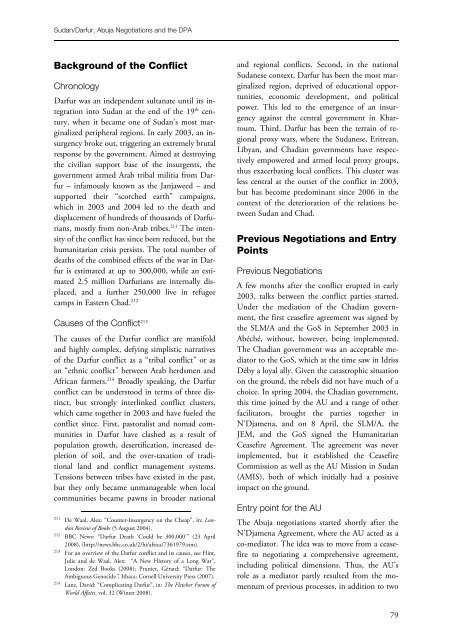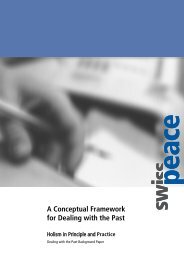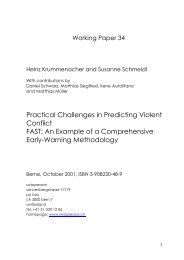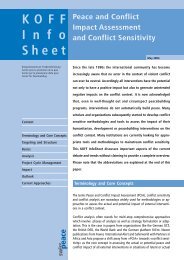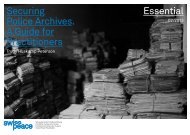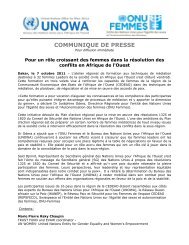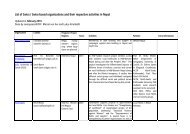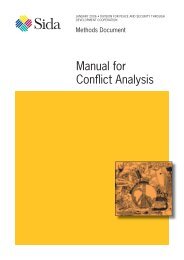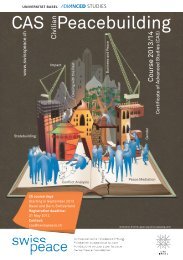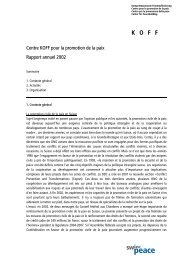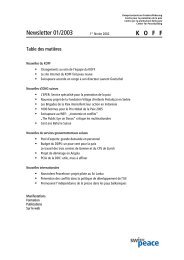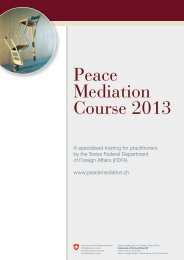Unpacking the Mystery of Mediation in African Peace ... - Swisspeace
Unpacking the Mystery of Mediation in African Peace ... - Swisspeace
Unpacking the Mystery of Mediation in African Peace ... - Swisspeace
You also want an ePaper? Increase the reach of your titles
YUMPU automatically turns print PDFs into web optimized ePapers that Google loves.
Sudan/Darfur, Abuja Negotiations and <strong>the</strong> DPA<br />
Background <strong>of</strong> <strong>the</strong> Conflict<br />
Chronology<br />
Darfur was an <strong>in</strong>dependent sultanate until its <strong>in</strong>tegration<br />
<strong>in</strong>to Sudan at <strong>the</strong> end <strong>of</strong> <strong>the</strong> 19 th century,<br />
when it became one <strong>of</strong> Sudan’s most marg<strong>in</strong>alized<br />
peripheral regions. In early 2003, an <strong>in</strong>surgency<br />
broke out, trigger<strong>in</strong>g an extremely brutal<br />
response by <strong>the</strong> government. Aimed at destroy<strong>in</strong>g<br />
<strong>the</strong> civilian support base <strong>of</strong> <strong>the</strong> <strong>in</strong>surgents, <strong>the</strong><br />
government armed Arab tribal militia from Darfur<br />
– <strong>in</strong>famously known as <strong>the</strong> Janjaweed – and<br />
supported <strong>the</strong>ir “scorched earth” campaigns,<br />
which <strong>in</strong> 2003 and 2004 led to <strong>the</strong> death and<br />
displacement <strong>of</strong> hundreds <strong>of</strong> thousands <strong>of</strong> Darfurians,<br />
mostly from non-Arab tribes. 211 The <strong>in</strong>tensity<br />
<strong>of</strong> <strong>the</strong> conflict has s<strong>in</strong>ce been reduced, but <strong>the</strong><br />
humanitarian crisis persists. The total number <strong>of</strong><br />
deaths <strong>of</strong> <strong>the</strong> comb<strong>in</strong>ed effects <strong>of</strong> <strong>the</strong> war <strong>in</strong> Darfur<br />
is estimated at up to 300,000, while an estimated<br />
2.5 million Darfurians are <strong>in</strong>ternally displaced,<br />
and a fur<strong>the</strong>r 250,000 live <strong>in</strong> refugee<br />
camps <strong>in</strong> Eastern Chad. 212<br />
Causes <strong>of</strong> <strong>the</strong> Conflict 213<br />
The causes <strong>of</strong> <strong>the</strong> Darfur conflict are manifold<br />
and highly complex, defy<strong>in</strong>g simplistic narratives<br />
<strong>of</strong> <strong>the</strong> Darfur conflict as a “tribal conflict” or as<br />
an “ethnic conflict” between Arab herdsmen and<br />
<strong>African</strong> farmers. 214 Broadly speak<strong>in</strong>g, <strong>the</strong> Darfur<br />
conflict can be understood <strong>in</strong> terms <strong>of</strong> three dist<strong>in</strong>ct,<br />
but strongly <strong>in</strong>terl<strong>in</strong>ked conflict clusters,<br />
which came toge<strong>the</strong>r <strong>in</strong> 2003 and have fueled <strong>the</strong><br />
conflict s<strong>in</strong>ce. First, pastoralist and nomad communities<br />
<strong>in</strong> Darfur have clashed as a result <strong>of</strong><br />
population growth, desertification, <strong>in</strong>creased depletion<br />
<strong>of</strong> soil, and <strong>the</strong> over-taxation <strong>of</strong> traditional<br />
land and conflict management systems.<br />
Tensions between tribes have existed <strong>in</strong> <strong>the</strong> past,<br />
but <strong>the</strong>y only became unmanageable when local<br />
communities became pawns <strong>in</strong> broader national<br />
211 De Waal, Alex: “Counter-Insurgency on <strong>the</strong> Cheap”, <strong>in</strong>: London<br />
Review <strong>of</strong> Books (5 August 2004).<br />
212 BBC News: “Darfur Death ‘Could be 300,000’” (23 April<br />
2008), (http://news.bbc.co.uk/2/hi/africa/7361979.stm).<br />
213 For an overview <strong>of</strong> <strong>the</strong> Darfur conflict and its causes, see Fl<strong>in</strong>t,<br />
Julie and de Waal, Alex: “A New History <strong>of</strong> a Long War”,<br />
London: Zed Books (2008); Prunier, Gérard: “Darfur: The<br />
Ambiguous Genocide”, Ithaca: Cornell University Press (2007).<br />
214 Lanz, David: “Complicat<strong>in</strong>g Darfur”, <strong>in</strong>: The Fletcher Forum <strong>of</strong><br />
World Affairs, vol. 32 (W<strong>in</strong>ter 2008).<br />
and regional conflicts. Second, <strong>in</strong> <strong>the</strong> national<br />
Sudanese context, Darfur has been <strong>the</strong> most marg<strong>in</strong>alized<br />
region, deprived <strong>of</strong> educational opportunities,<br />
economic development, and political<br />
power. This led to <strong>the</strong> emergence <strong>of</strong> an <strong>in</strong>surgency<br />
aga<strong>in</strong>st <strong>the</strong> central government <strong>in</strong> Khartoum.<br />
Third, Darfur has been <strong>the</strong> terra<strong>in</strong> <strong>of</strong> regional<br />
proxy wars, where <strong>the</strong> Sudanese, Eritrean,<br />
Libyan, and Chadian governments have respectively<br />
empowered and armed local proxy groups,<br />
thus exacerbat<strong>in</strong>g local conflicts. This cluster was<br />
less central at <strong>the</strong> outset <strong>of</strong> <strong>the</strong> conflict <strong>in</strong> 2003,<br />
but has become predom<strong>in</strong>ant s<strong>in</strong>ce 2006 <strong>in</strong> <strong>the</strong><br />
context <strong>of</strong> <strong>the</strong> deterioration <strong>of</strong> <strong>the</strong> relations between<br />
Sudan and Chad.<br />
Previous Negotiations and Entry<br />
Po<strong>in</strong>ts<br />
Previous Negotiations<br />
A few months after <strong>the</strong> conflict erupted <strong>in</strong> early<br />
2003, talks between <strong>the</strong> conflict parties started.<br />
Under <strong>the</strong> mediation <strong>of</strong> <strong>the</strong> Chadian government,<br />
<strong>the</strong> first ceasefire agreement was signed by<br />
<strong>the</strong> SLM/A and <strong>the</strong> GoS <strong>in</strong> September 2003 <strong>in</strong><br />
Abéché, without, however, be<strong>in</strong>g implemented.<br />
The Chadian government was an acceptable mediator<br />
to <strong>the</strong> GoS, which at <strong>the</strong> time saw <strong>in</strong> Idriss<br />
Déby a loyal ally. Given <strong>the</strong> catastrophic situation<br />
on <strong>the</strong> ground, <strong>the</strong> rebels did not have much <strong>of</strong> a<br />
choice. In spr<strong>in</strong>g 2004, <strong>the</strong> Chadian government,<br />
this time jo<strong>in</strong>ed by <strong>the</strong> AU and a range <strong>of</strong> o<strong>the</strong>r<br />
facilitators, brought <strong>the</strong> parties toge<strong>the</strong>r <strong>in</strong><br />
N’Djamena, and on 8 April, <strong>the</strong> SLM/A, <strong>the</strong><br />
JEM, and <strong>the</strong> GoS signed <strong>the</strong> Humanitarian<br />
Ceasefire Agreement. The agreement was never<br />
implemented, but it established <strong>the</strong> Ceasefire<br />
Commission as well as <strong>the</strong> AU Mission <strong>in</strong> Sudan<br />
(AMIS), both <strong>of</strong> which <strong>in</strong>itially had a positive<br />
impact on <strong>the</strong> ground.<br />
Entry po<strong>in</strong>t for <strong>the</strong> AU<br />
The Abuja negotiations started shortly after <strong>the</strong><br />
N’Djamena Agreement, where <strong>the</strong> AU acted as a<br />
co-mediator. The idea was to move from a ceasefire<br />
to negotiat<strong>in</strong>g a comprehensive agreement,<br />
<strong>in</strong>clud<strong>in</strong>g political dimensions. Thus, <strong>the</strong> AU’s<br />
role as a mediator partly resulted from <strong>the</strong> momentum<br />
<strong>of</strong> previous processes, <strong>in</strong> addition to two<br />
79


